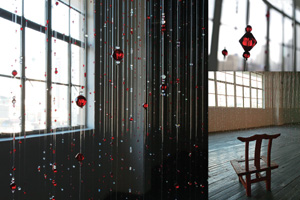Embracing the Silent Voice of Secret Script
Back to Contents of Issue: January 2005
|
|
|
|
by Toshiyo Nishitani |
|
 As Nushu was co-developed with their craft works, the characters were often disguised in their embroidery. The tilted style of Nushu writing reflects the fact that Nushu was originally embroidered rather than written. Its exact origin is still a mystery. Being ignored by men, Nushu was virtually a secret script for centuries. It was not until 1983 that the script came to the attention of Chinese scholars. As Nushu was co-developed with their craft works, the characters were often disguised in their embroidery. The tilted style of Nushu writing reflects the fact that Nushu was originally embroidered rather than written. Its exact origin is still a mystery. Being ignored by men, Nushu was virtually a secret script for centuries. It was not until 1983 that the script came to the attention of Chinese scholars.
Nushu was doomed to disappear. Many manuscripts were destroyed in the Cultural Revolution (1966--76), partly because of suspicion the script was a spy code and partly because it was regarded as a reflection of Chinese feudalism. After the liberation in 1949, with the spread of Hanzi (Chinese character) education, the Nushu script fell into disuse. The beauty of Nushu was recently embodied by Yuca Ishizuka in her art work called "Semiotic Space: A Case for an Endangered Language" at "Matchmaking at Suzhou Creek: Shanghai Biennale Satellite Group Project." In celebration of the Nushu women's achievement and perseverance, Ishizuka created what she calls "gendered space," an ephemeral world of femininity. In a spacious room of the Eastlink gallery, a remodeled textile warehouse, she strung more than 30,000 red and transparent Swarovski crystal beads of various shapes and sizes on threads hung from the high ceiling. Five hundred strands, each with a different combination of beads, suggested vertical lines of Nushu characters. The hanging strands diminish in density from one end of the installation to the other in a spatial analogue of Nushu's fading away to extinction. Visitors could walk through a narrow passage into a shower of crystals at the center of Ishizuka's installation. With hesitation they touched the crystals as if to confirm they are not seeing an illusion. They listened to the luminous whisper of the strands undulating in a breath of wind, and imagined they heard the silent voice of Nushu. Ishizuka's "Semiotic Space" emotionally and physically engages the viewer. All of her esoteric and idiosyncratic works are intelligent juxtapositions of sensory experience. Because she always exploits elements intrinsic in the exhibition site, each of her installations differs in texture. In Shanghai, the luminous delicate crystals contrast with the modern cityscape framed in the tall windows, suggesting Nushu's vanishing into the ever-waxing energy of Shanghai. Her manipulation of Swarovski beads, set in natural light, allowed crystals to emit an emotional glow of sorrow and dignity. Nushu's demise seems to render the strands of crystals a forest of floating teardrops. Her exposure and fascination with language and culture began early and expanded with her experience living in the U.S, U.K and Italy. Her study of art at Goldsmith College, in London, confirmed her hybrid way of conceptualization with a basis in the observation that language not only gives the freedom to communicate but also restricts one's worldview. She compared the grammatical structure and conceptualization unique to discrete language to a filter through which the world is viewed. Being multilingual with an especial interest in languages allows her to look at the world through multilayered filters, diversifying her cognitive process and helping shape the identity of her art work. Ishizuka first learned of Nushu about three years ago. "I was simply overwhelmed by its powerful history," she recalled. "Ever since then, the thought of doing an art project on Nushu never left my mind." She fulfilled her wish in Shanghai in September 2004. Embracing the Nushu writers' history with respect and admiration, she encoded their secrets of creativity in her work. Just as Nushu writing was the product of the fervent desire for communication, Ishizuka's art derived from a passion to bridge the gap between visitors and the Nushu world. As Ishizuka was preparing the installation in Shanghai, Yang Huanyi, the last person with genuine knowledge of Nushu, passed away, on September 20. Ishizuka's installation served as a shimmering final embodiment of the script and proved there are ways to approach history other than by placing its legacies in a glass case in a museum. ***** "Semiotic Space: A Case for an Endangered Language" was made possible by the support of Swarovski Japan. Individuals and organizations interested in sponsoring Ishizuka's future activities can contact the artist at xyucax@mac.com http://homepage.mac.com/xyucax/ Photographs by Mitch Tsunoda |
|
Note: The function "email this page" is currently not supported for this page.





